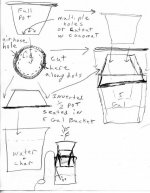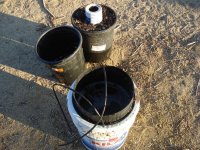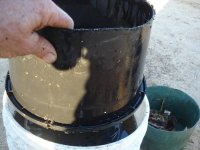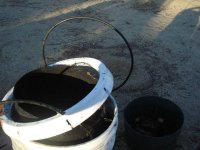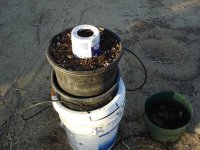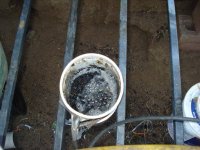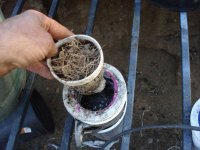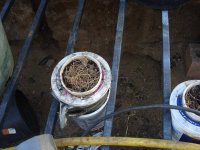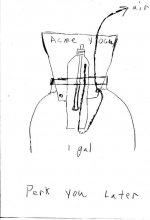With all due respect to the innovators and those building quality buckets. I've came up with a few slap together versions. In all honesty they haven't worked that well. Close but no banana. Success in my book though. Anybody can follow instructions.
The first involves a water pump. Good for tea, bad for air injection. The second attempt was 2 buckets stacked with aeration holes in the top bucket and the air hose in the bottom bucket. Leaked air like my last girlfriend. Placing the air directly in the top bucket gave maximum injection. The lower bucket remains as a reservoir. To drain simply pull apart and dump lower bucket. An innertube around the top bucket holds it up and provides a semi seal. Overflow is the top of the bottom bucket.
Too complicated.
A simple plastic pot with a bio bucket mix and an airstone at the bottom set in a 5 gallon bucket as a reservoir. The innertube us nice, but probably not neccassary.
So much fun. Again with due respect to serious builders of the box, this is my toy that I can deconstruct, reconstruct, or break. It allows me to tweak and refine what I've been doing for 40 years as a gardener.
My bio mix at this point consists of MG organic soil mix, perlite, palm tree fiber, yucca fiber and bark and some ewc. The volcanic rock was gathered in my backyard. It's all about cheap and recycling what I can. I'm looking at ground oyster shells sold for birds instead of lime. Lime is not sold locally which is a stipulation I've placed on myself as well.
Will it all work? I don't know. Will I learn something. I already have.
Club bio...
https://www.icmag.com/ic/showthread.php?t=137656
The first involves a water pump. Good for tea, bad for air injection. The second attempt was 2 buckets stacked with aeration holes in the top bucket and the air hose in the bottom bucket. Leaked air like my last girlfriend. Placing the air directly in the top bucket gave maximum injection. The lower bucket remains as a reservoir. To drain simply pull apart and dump lower bucket. An innertube around the top bucket holds it up and provides a semi seal. Overflow is the top of the bottom bucket.
Too complicated.
A simple plastic pot with a bio bucket mix and an airstone at the bottom set in a 5 gallon bucket as a reservoir. The innertube us nice, but probably not neccassary.
So much fun. Again with due respect to serious builders of the box, this is my toy that I can deconstruct, reconstruct, or break. It allows me to tweak and refine what I've been doing for 40 years as a gardener.
My bio mix at this point consists of MG organic soil mix, perlite, palm tree fiber, yucca fiber and bark and some ewc. The volcanic rock was gathered in my backyard. It's all about cheap and recycling what I can. I'm looking at ground oyster shells sold for birds instead of lime. Lime is not sold locally which is a stipulation I've placed on myself as well.
Will it all work? I don't know. Will I learn something. I already have.
Club bio...
https://www.icmag.com/ic/showthread.php?t=137656

